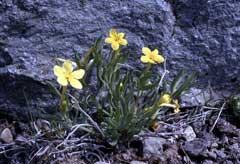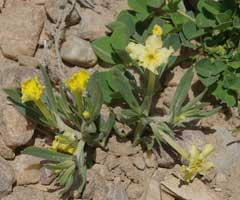 |
|
http://www.nps.gov |
 |
| http://commons.wikimedia.org/wiki/User:JerryFriedman |
Translate this page:
Summary
Physical Characteristics

 Lithospermum incisum is a PERENNIAL growing to 0.3 m (1ft).
Lithospermum incisum is a PERENNIAL growing to 0.3 m (1ft).
See above for USDA hardiness. It is hardy to UK zone 3. It is in flower in June. The species is hermaphrodite (has both male and female organs) and is pollinated by Insects.
Suitable for: light (sandy) and medium (loamy) soils and prefers well-drained soil. Suitable pH: neutral and basic (mildly alkaline) soils. It cannot grow in the shade. It prefers dry or moist soil.
UK Hardiness Map
US Hardiness Map
Synonyms
L. angustifolium. Michx. L. breviflorum.
Plant Habitats
Cultivated Beds;
Edible Uses
Edible Parts: Root
Edible Uses: Tea
Root - cooked[105, 161, 207, 212]. Eaten boiled or roasted[257]. The root has been used to make a tea[257].
References More on Edible Uses
Medicinal Uses
Plants For A Future can not take any responsibility for any adverse effects from the use of plants. Always seek advice from a professional before using a plant medicinally.
Contraceptive Kidney Miscellany Ophthalmic Pectoral Stomachic
The root has been chewed by some native North American Indian tribes as a treatment for colds[213]. The finely powdered leaves, root and stem have been rubbed on the body in the treatment of paralyzed limbs[257]. An infusion of the root has been used in the treatment of stomach aches and kidney problems[257]. The plant has been eaten as an oral contraceptive and also as a treatment for lung haemorrhages, coughs and colds[257]. A cold infusion of the pulverized root and seed has been used as an eyewash[257]. This plant was used as a medicine by various native North American Indian tribes and interest in the plant has revived recently as a possible source of modern drugs[212]. No more details are given.
References More on Medicinal Uses
The Bookshop: Edible Plant Books
Our Latest books on Perennial Plants For Food Forests and Permaculture Gardens in paperback or digital formats.

Edible Tropical Plants
Food Forest Plants for Hotter Conditions: 250+ Plants For Tropical Food Forests & Permaculture Gardens.
More

Edible Temperate Plants
Plants for Your Food Forest: 500 Plants for Temperate Food Forests & Permaculture Gardens.
More

More Books
PFAF have eight books available in paperback and digital formats. Browse the shop for more information.
Shop Now
Other Uses
Beads Dye Incense Miscellany
The dried plant tops have been burnt as an incense[257]. A blue dye has been obtained from the roots[257]. A red dye is obtained from the roots[274]. It is quite possible that both colours can be obtained, depending on the mordant used[K]. The seeds have been used as beads[257].
Special Uses
References More on Other Uses
Cultivation details
Requires a warm sunny position in a moderately fertile well-drained soil[1, 200]. Dislikes acid soils[1]. After producing large, conspicuous flowers in the spring, the plant produces lots of small very fertile cleistogamous flowers[274].
References Carbon Farming Information and Carbon Sequestration Information
Temperature Converter
Type a value in the Celsius field to convert the value to Fahrenheit:
Fahrenheit:
The PFAF Bookshop
Plants For A Future have a number of books available in paperback and digital form. Book titles include Edible Plants, Edible Perennials, Edible Trees,Edible Shrubs, Woodland Gardening, and Temperate Food Forest Plants. Our new book is Food Forest Plants For Hotter Conditions (Tropical and Sub-Tropical).
Shop Now
Plant Propagation
Seed - sow spring in a cold frame. When they are large enough to handle, prick the seedlings out into individual pots and grow them on in the greenhouse for their first winter. Plant them out into their permanent positions in late spring or early summer, after the last expected frosts. Cuttings. Division.
Other Names
If available other names are mentioned here
Native Plant Search
Search over 900 plants ideal for food forests and permaculture gardens. Filter to search native plants to your area. The plants selected are the plants in our book 'Plants For Your Food Forest: 500 Plants for Temperate Food Forests and Permaculture Gardens, as well as plants chosen for our forthcoming related books for Tropical/Hot Wet Climates and Mediterranean/Hot Dry Climates. Native Plant Search
Found In
Countries where the plant has been found are listed here if the information is available
Weed Potential
Right plant wrong place. We are currently updating this section.
Please note that a plant may be invasive in one area but may not in your area so it’s worth checking.
Conservation Status
IUCN Red List of Threatened Plants Status :

Growth: S = slow M = medium F = fast. Soil: L = light (sandy) M = medium H = heavy (clay). pH: A = acid N = neutral B = basic (alkaline). Shade: F = full shade S = semi-shade N = no shade. Moisture: D = dry M = Moist We = wet Wa = water.

Expert comment
Author
Lehm.
Botanical References
43200274
Links / References
For a list of references used on this page please go here
Readers comment